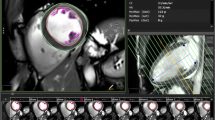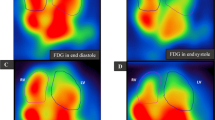Abstract
Purpose
Dual-isotope simultaneous acquisition single-photon emission computed tomography (DISA SPECT) with 18F-fluorodeoxyglucose (FDG) and 99mTc-sestamibi appears attractive for the detection of viable myocardium because it permits simultaneous assessment of glucose utilisation and perfusion. Another potential benefit of this approach is that the measurement of left ventricular (LV) function may be possible by ECG gating. The aim of this study was to test the hypothesis that both myocardial viability and LV function can be assessed by a single ECG-gated 18F-FDG/99mTc-sestamibi DISA SPECT study, based on comparison with 18F-FDG/13N-ammonia positron emission tomography (PET) and magnetic resonance imaging (MRI) as reference techniques.
Methods
Thirty-three patients with prior myocardial infarction underwent ECG-gated 18F-FDG/99mTc-sestamibi DISA SPECT and 18F-FDG/13N-ammonia PET on a single day. Of these, 25 patients also underwent cine-MRI to assess LV function. The LV myocardium was divided into nine regions, and each region was classified as viable or scar using a semiquantitative visual scoring system as well as quantitative analysis. The global and regional LV function measured by gated SPECT was compared with the results of MRI.
Results
There was good agreement in respect of viability (90–96%, κ 0.74–0.85) between DISA SPECT and PET by either visual or quantitative analysis. Furthermore, although both global and regional LV function measured by gated SPECT agreed with those by MRI, 99mTc-sestamibi showed a closer correlation with MRI than did 18F-FDG.
Conclusion
In conclusion, ECG-gated DISA SPECT provides information on myocardial viability, as well as global and regional LV function, similar to that obtained by PET and MRI.






Similar content being viewed by others
References
Tillisch J, Brunken R, Marshall R, Schwaiger M, Mandelkern M, Phelps M, Schelbert H. Reversibility of cardiac wall-motion abnormalities predicted by positron tomography. N Engl J Med 1986;314:884–8.
Tamaki N, Kawamoto M, Tadamura E, Magata Y, Yonekura Y, Nohara R, et al. Prediction of reversible ischemia after revascularization. Perfusion and metabolic studies with positron emission tomography. Circulation 1995;91:1697–705.
Bax JJ, Cornel JH, Visser FC, Fioretti PM, van Lingen A, Reijs AE, et al. Prediction of recovery of myocardial dysfunction after revascularization. Comparison of fluorine-18 fluorodeoxyglucose/thallium-201 SPECT, thallium-201 stress-reinjection SPECT and dobutamine echocardiography. J Am Coll Cardiol 1996;28:558–64.
Srinivasan G, Kitsiou AN, Bacharach SL, Bartlett ML, Miller-Davis C, Dilsizian V. [18F]fluorodeoxyglucose single photon emission computed tomography: can it replace PET and thallium SPECT for the assessment of myocardial viability? Circulation 1998;97:843–50.
Sandler MP, Videlefsky S, Delbeke D, Patton JA, Meyerowitz C, Martin WH, Ohana I. Evaluation of myocardial ischemia using a rest metabolism/stress perfusion protocol with fluorine-18 deoxyglucose/technetium-99m MIBI and dual-isotope simultaneous-acquisition single-photon emission computed tomography. J Am Coll Cardiol 1995;26:870–8.
Sandler MP, Bax JJ, Patton JA, Visser FC, Martin WH, Wijns W. Fluorine-18-fluorodeoxyglucose cardiac imaging using a modified scintillation camera. J Nucl Med 1998;39:2035–43.
Matsunari I, Kanayama S, Yoneyama T, Matsudaira M, Nakajima K, Taki J, et al. Myocardial distribution of 18F-FDG and 99mTc-sestamibi on dual-isotope simultaneous acquisition SPET compared with PET. Eur J Nucl Med Mol Imaging 2002;29:1357–64.
Matsunari I, Boning G, Ziegler SI, Nekolla SG, Stollfuss JC, Kosa I, et al. Attenuation-corrected 99mTc-tetrofosmin single-photon emission computed tomography in the detection of viable myocardium: comparison with positron emission tomography using 18F-fluorodeoxyglucose. J Am Coll Cardiol 1998;32:927–35.
Delbeke D, Videlefsky S, Patton JA, Campbell MG, Martin WH, Ohana I, Sandler MP. Rest myocardial perfusion/metabolism imaging using simultaneous dual-isotope acquisition SPECT with technetium-99m-MIBI/fluorine-18-FDG. J Nucl Med 1995;36:2110–9.
vom-Dahl J, Eitzman DT, Al-Aouar ZR, Kanter HL, Hicks RJ, Deeb GM, et al. Relation of regional function, perfusion, and metabolism in patients with advanced coronary artery disease undergoing surgical revascularization. Circulation 1994;90:2356–66.
Nekolla SG, Miethaner C, Nguyen N, Ziegler SI, Schwaiger M. Reproducibility of polar map generation and assessment of defect severity and extent assessment in myocardial perfusion imaging using positron emission tomography. Eur J Nucl Med 1998;25:1313–21.
Sawada SG, Allman KC, Muzik O, Beanlands RS, Wolfe E Jr, Gross M, et al. Positron emission tomography detects evidence of viability in rest technetium-99m sestamibi defects. J Am Coll Cardiol 1994;23:92–8.
Taki J, Higuchi T, Nakajima K, Matsunari I, Hwang EH, Bunko H, et al. Electrocardiographic gated 99mTc-MIBI SPECT for functional assessment of patients after coronary artery bypass surgery: comparison of wall thickening and wall motion analysis. J Nucl Med 2002;43:589–95.
Holman ER, Buller VG, de Roos A, van der Geest RJ, Baur LH, van der Laarse A, et al. Detection and quantification of dysfunctional myocardium by magnetic resonance imaging. A new three-dimensional method for quantitative wall-thickening analysis. Circulation 1997;95:924–31.
Udelson JE, Coleman PS, Metherall J, Pandian NG, Gomez AR, Griffith JL, et al. Predicting recovery of severe regional ventricular dysfunction. Comparison of resting scintigraphy with 201Tl and 99mTc-sestamibi. Circulation 1994;89:2552–61.
Bax JJ, Visser FC, van Lingen A, Huitink JM, Kamp O, van Leeuwen GR, et al. Feasibility of assessing regional myocardial uptake of 18F-fluorodeoxyglucose using single photon emission computed tomography. Eur Heart J 1993;14:1675–82.
Bax JJ, Visser FC, Blanksma PK, Veening MA, Tan ES, Willemsen TM, et al. Comparison of myocardial uptake of fluorine-18-fluorodeoxyglucose imaged with PET and SPECT in dyssynergic myocardium. J Nucl Med 1996;37:1631–36.
Matsunari I, Fujino S, Taki J, Senma J, Aoyama T, Wakasugi T, et al. Quantitative rest technetium-99m tetrofosmin imaging in predicting functional recovery after revascularization: comparison with rest-redistribution thallium-201. J Am Coll Cardiol 1997;29:1226–33.
Pagnanelli RA, Hanson MW, Turkington T, Coleman RE, Borges-Neto S. Gated 99mTc-tetrofosmin and 18F-FDG studies: a comparison of single-acquisition and separate-acquisition protocols. J Nucl Med Technol 2002;30:175–8.
Stollfuss JC, Haas F, Matsunari I, Neverve J, Nekolla S, Schneider-Eicke J, et al. Regional myocardial wall thickening and global ejection fraction in patients with low angiographic left ventricular ejection fraction assessed by visual and quantitative resting ECG-gated 99mTc-tetrofosmin single-photon emission tomography and magnetic resonance imaging. Eur J Nucl Med 1998;25:522–30.
Ioannidis JP, Trikalinos TA, Danias PG. Electrocardiogram-gated single-photon emission computed tomography versus cardiac magnetic resonance imaging for the assessment of left ventricular volumes and ejection fraction: a meta-analysis. J Am Coll Cardiol 2002;39:2059–68.
Fukuchi K, Katafuchi T, Fukushima K, Shimotsu Y, Toba M, Hayashida K, et al. Estimation of myocardial perfusion and viability using simultaneous 99mTc-tetrofosmin–FDG collimated SPECT. J Nucl Med 2000;41:1318–23.
Bax JJ, Cornel JH, Visser FC, Fioretti PM, van Lingen A, Huitink JM, et al. Prediction of improvement of contractile function in patients with ischemic ventricular dysfunction after revascularization by fluorine-18 fluorodeoxyglucose single-photon emission computed tomography. J Am Coll Cardiol 1997;30:377–83.
Author information
Authors and Affiliations
Corresponding author
Rights and permissions
About this article
Cite this article
Matsunari, I., Kanayama, S., Yoneyama, T. et al. Electrocardiographic-gated dual-isotope simultaneous acquisition SPECT using 18F-FDG and 99mTc-sestamibi to assess myocardial viability and function in a single study. Eur J Nucl Med Mol Imaging 32, 195–202 (2005). https://doi.org/10.1007/s00259-004-1668-9
Received:
Accepted:
Published:
Issue Date:
DOI: https://doi.org/10.1007/s00259-004-1668-9




